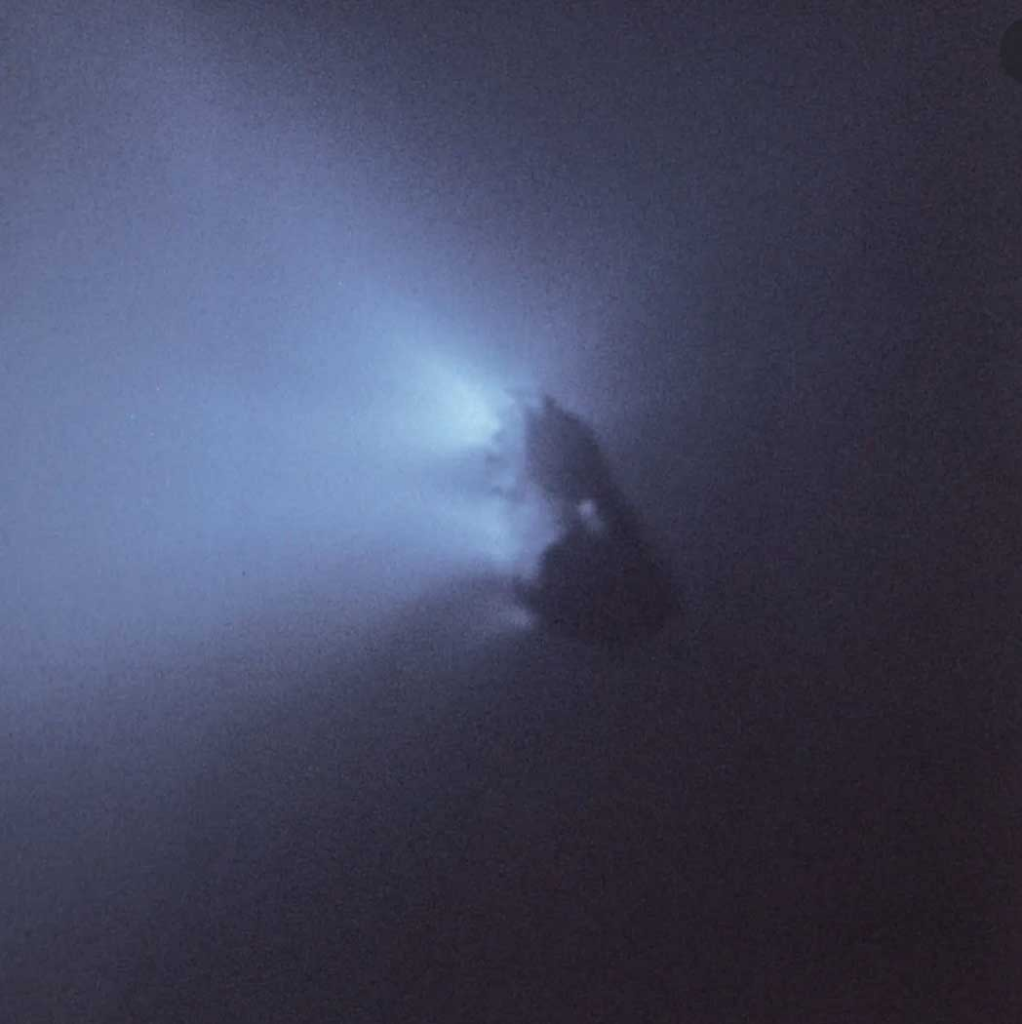Sky Report: October 17 – 23

The evaporating nucleus of Comet Halley as photographed by the Giotto spacecraft in 1986. The copious amount of debris being shed will become future meteors if the particles reach earth. Credit: European Space Agency.
The highlight of this week is a modest meteor shower which peaks on the morning of the 21st. These meteors are debris shed by Comet Halley as the sun heats the frozen dirty iceball that is the comet, thaws it, and liberates dust particles mixed in with its ice. It’s called the Orionid Shower because the meteors radiate from the direction of Orion, which rises before midnight but is highest in the predawn hours, so the best time to watch is after midnight on the morning of the 21st and the morning before and after. Expect to see 10 to 20 meteors per hour. Although they radiate from a point NE of Betelgeuse, they’ll appear all over the sky. Because we meet these particles nearly head-on they hit our atmosphere at 150,000 miles per hour, which is as fast as meteors can be.
When you do see an Orionid meteor you’re seeing a particle that for millennia has traveled with Comet Halley around the sun and across our sky and is now destroyed in its brief fiery passage through our atmosphere.
Comet Halley is presently in the constellation Hydra, near the far end of its elongated orbit around the sun, over 3 billion miles from earth, beyond the orbit of Neptune, inbound, and due to return in 2061.
You won’t see Halley’s Comet tonight but you can see three bright planets in the evening sky, and from right (west) to left (east) they are Saturn, Jupiter, and Mars.
Jupiter is the brightest. It’s well up in the southeast as darkness falls, is halfway up the southern sky shortly after midnight, and sets in the west three hours before sunrise. I think Jupiter is the most interesting planet to observe with a telescope because even a small telescope shows its four moons, which change positions nightly and even hourly, and a moderate telescope 5-inches or larger will show its darker cloud bands. Its famous Red Spot, by the way, has faded dramatically in recent years and is no longer obvious.
Jupiter is interesting because it changes so quickly but Saturn is prettier – because of the rings. The planet itself is a small ball with only one cloud band visible to even excellent telescopes, but the rings are special. As detailed in Sky Report two weeks ago, this year the rings are tilted only 14° to our line-of-sight, but they’re still a striking sight.
Mars rises north of northeast at around 10:30 and is at its highest at around 5 a.m. when it’s nearly overhead. Mars is so bright that if it were where Jupiter or Saturn is, it would be obvious, since these two planets are in a part of the sky that has no bright stars to compete. But Mars is surrounded by bright stars in the winter Milky Way. It’s the brightest and reddest “star” in Taurus. Mars is a small planet 60 million miles from earth so even excellent telescopes show very few surface features.
Stellar Vista Observatory provides portable telescopes and tripod mounted binocular kits on loan for free to residents and visitors in Kane County. Enhance your enjoyment of the night sky! For details or to request a loan, visit https://stellarvistaobservatory.org/discover-the-night-sky/ or drop in to the Kane County Office of Tourism.
The Sky Report is presented as a public service by the Stellar Vista Observatory, a nonprofit organization based in Kanab, Utah, which provides opportunities for people to observe, appreciate, and comprehend our starry night sky. Additional information is at www.stellarvistaobservatory.org. Send questions and comments to John@StargazingAdventures.org.
John Mosley was Program Supervisor of the Griffith Observatory in Los Angeles for 27 years and is the author of “Stargazing for Beginners” and “Stargazing with Binoculars and Telescopes”. He and his wife live in St. George where he continues to stargaze from his retirement home while serving on the advisory committee for Stellar Vista Observatory.






Comments are closed.